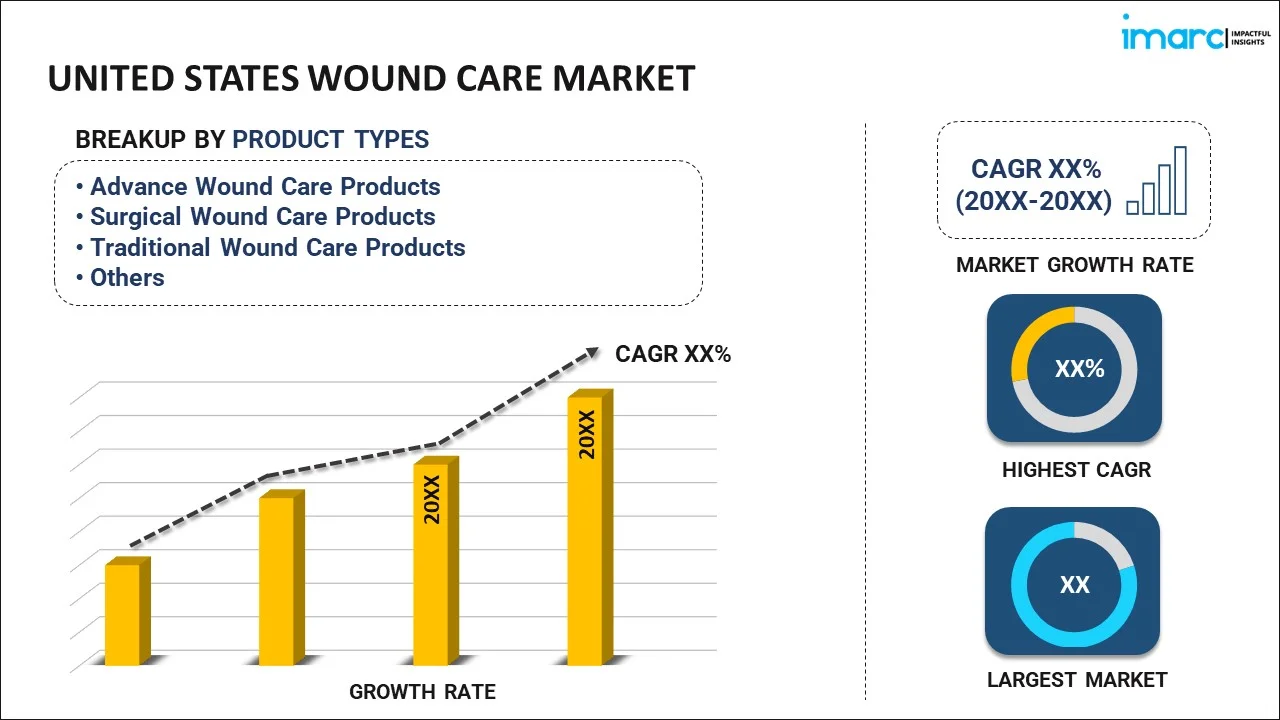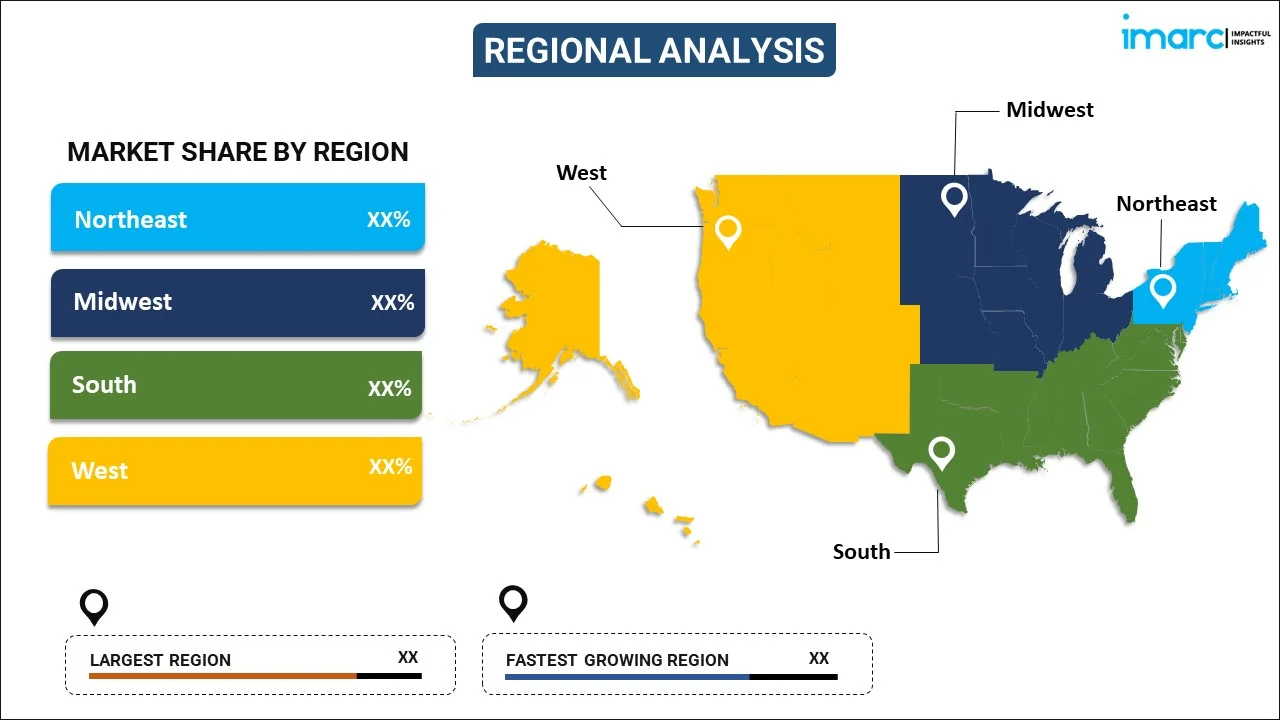
United States Wound Care Market Report by Product Type (Advance Wound Care Products, Surgical Wound Care Products, Traditional Wound Care Products, Active Wound Care Products, Wound Therapy Devices Products), Wound Type (Chronic Wounds, Acute Wounds), End User (Hospitals & Clinics, Long-Term Care Facilities, Home Care Setting, and Others), and Region 2025-2033
Market Overview:
The United States wound care market size is projected to exhibit a growth rate (CAGR) of 3.63% during 2025-2033. The rising prevalence of chronic wounds and the inflating number of surgical procedures, significant technological advancements, rising healthcare expenditure, growing preference for home healthcare services, and increasing focus on patient satisfaction represent some of the key factors driving the market.
|
Report Attribute
|
Key Statistics
|
|---|---|
|
Base Year
|
2024
|
|
Forecast Years
|
2025-2033
|
|
Historical Years
|
2019-2024
|
| Market Growth Rate (2025-2033) | 3.63% |
Wound care refers to the specific type of medical treatment and management applied to injuries that break the skin or other body membranes. The primary objective of wound care is to promote healing, minimize the risk of infection, alleviate pain, and prevent future complications. Wounds can be categorized into acute (such as surgical incisions or traumatic injuries) and chronic (such as ulcers or pressure sores), each requiring distinct care approaches. The wound care process typically begins with a thorough cleaning to remove debris and bacteria. This is followed by the application of appropriate dressings or bandages that maintain a moist environment conducive to healing. Antiseptics, antibiotics, or anti-inflammatory medications might be used to prevent or treat infections and reduce inflammation. Modern wound care also includes advanced therapies like hyperbaric oxygen therapy, negative pressure wound therapy, and the use of biologically active dressings that can enhance the body's natural healing response. Specialized wound care professionals, including nurses, doctors, and therapists, are often trained in handling various wound types and complexities.
United States Wound Care Market Trends:
The rising prevalence of diabetes, obesity, and cardiovascular diseases represents one of the key factors driving the growth of the market across the United States. In addition to this, the increasing incidences of lifestyle-related injuries and conditions necessitate a robust market to cater to diverse needs, which is contributing to the growth of the market. The market is also driven by innovations in wound care products, such as smart dressings, biologics, and negative pressure wound therapy, which offer efficient and personalized care solutions. In line with this, the growing preference for home healthcare services, including wound management, reflects a trend toward personalized and comfortable care, which is driving the market growth. The rising emphasis on patient satisfaction and outcomes fuels the demand for quality wound care products that minimize discomfort and expedite healing which is boosting the growth of the market. Apart from this, the increasing investment in research and development (R&D) by both private and public sectors is leading to continuous innovation and development in wound care methodologies which are propelling the growth of the market. Favorable reimbursement scenarios are encouraging the use of advanced wound care products and services by lowering financial barriers for patients which is facilitating the growth of the market. Moreover, the rising healthcare infrastructure, and increasing awareness about wound care and prevention among both healthcare providers and the public are some of the other factors creating a positive outlook for the market across the country.
United States Wound Care Market Segmentation:
IMARC Group provides an analysis of the key trends in each segment of the United States wound care market report, along with forecasts at the country level for 2025-2033. Our report has categorized the market based on product type, wound type, and end user.
Product Type Insights:

- Advance Wound Care Products
- Foam Dressing
- Hydrocolloid Dressing
- Film Dressing
- Alginate Dressing
- Hydrogel Dressing
- Collagen Dressing
- Others
- Surgical Wound Care Products
- Sutures
- Staplers
- Tissue Adhesive, Sealants & Hemostats
- Anti-Effective Dressing
- Traditional Wound Care Products
- Medical Tapes
- Cleansing Agent
- Active Wound Care Products
- Biological Skin Substitutes
- Topical Agents
- Wound Therapy Devices Products
- Negative Pressure Wound Therapy
- Oxygen and Hyperbaric Oxygen Equipment
- Electric Stimulation Devices
- Pressure Relief Devices
- Wound Assessment & Monitoring Devices
- Others
The report has provided a detailed breakup and analysis of the market based on the product type. This includes advance wound care products (foam dressing, hydrocolloid dressing, film dressing, alginate dressing, hydrogel dressing, collagen dressing, and others), surgical wound care products (sutures, staplers, tissue adhesive, sealants & hemostats, and anti-effective dressing), traditional wound care products (medical tapes and cleansing agent), active wound care products (biological skin substitutes, and topical agents), and wound therapy devices products (negative pressure wound therapy, oxygen and hyperbaric oxygen equipment, electric stimulation devices, pressure relief devices, wound assessment & monitoring devices, others).
Wound Type Insights:
- Chronic Wounds
- Diabetics Ulcers
- Pressure Ulcers
- Venous Leg Ulcers
- Others
- Acute Wounds
- Surgical Traumatic Wounds
- Burns
A detailed breakup and analysis of the market based on the wound type has also been provided in the report. This includes plastic chronic wounds (diabetics ulcers, pressure ulcers, venous leg ulcers, and others) and acute wounds (surgical traumatic wounds and burns).
End User Insights:
- Hospitals & Clinics
- Long-Term Care Facilities
- Home Care Setting
- Others
A detailed breakup and analysis of the market based on the end user has also been provided in the report. This includes hospitals & clinics, long-term care facilities, home care setting, and others.
Regional Insights:

- Northeast
- Midwest
- South
- West
The report has also provided a comprehensive analysis of all the major regional markets, which include the Northeast, Midwest, South, and West.
Competitive Landscape:
The report has also provided a comprehensive analysis of the competitive landscape in the United States wound care market. Competitive analysis such as market structure, key player positioning, top winning strategies, competitive dashboard, and company evaluation quadrant has been covered in the report. Also, detailed profiles of all major companies have been provided.
United States Wound Care Market Report Scope:
| Report Features | Details |
|---|---|
| Base Year of the Analysis | 2024 |
| Historical Period | 2019-2024 |
| Forecast Period | 2025-2033 |
| Units | Billion USD |
| Scope of the Report | Exploration of Historical and Forecast Trends, Industry Catalysts and Challenges, Segment-Wise Historical and Predictive Market Assessment:
|
| Product Types Covered |
|
| Wound Types Covered |
|
| End Users Covered | Hospitals & Clinics, Long-Term Care Facilities, Home Care Setting, Others |
| Regions Covered | Northeast, Midwest, South, and West |
| Customization Scope | 10% Free Customization |
| Post-Sale Analyst Support | 10-12 Weeks |
| Delivery Format | PDF and Excel through Email (We can also provide the editable version of the report in PPT/Word format on special request) |
Key Questions Answered in This Report:
- How has the United States wound care market performed so far and how will it perform in the coming years?
- What has been the impact of COVID-19 on the United States wound care market?
- What is the breakup of the United States wound care market on the basis of product type?
- What is the breakup of the United States wound care market on the basis of the wound type?
- What is the breakup of the United States wound care market on the basis of end user?
- What are the various stages in the value chain of the United States wound care market?
- What are the key driving factors and challenges in the United States wound care market?
- What is the structure of the United States wound care market and who are the key players?
- What is the degree of competition in the United States wound care market?
Key Benefits for Stakeholders:
- IMARC’s report offers a comprehensive quantitative analysis of various market segments, historical and current market trends, market forecasts, and dynamics of the United States wound care market from 2019-2033.
- The research study provides the latest information on the market drivers, challenges, and opportunities in the United States wound care market.
- Porter's five forces analysis assist stakeholders in assessing the impact of new entrants, competitive rivalry, supplier power, buyer power, and the threat of substitution. It helps stakeholders to analyze the level of competition within the United States wound care industry and its attractiveness.
- Competitive landscape allows stakeholders to understand their competitive environment and provides an insight into the current positions of key players in the market.
Need more help?
- Speak to our experienced analysts for insights on the current market scenarios.
- Include additional segments and countries to customize the report as per your requirement.
- Gain an unparalleled competitive advantage in your domain by understanding how to utilize the report and positively impacting your operations and revenue.
- For further assistance, please connect with our analysts.
 Inquire Before Buying
Inquire Before Buying
 Speak to an Analyst
Speak to an Analyst
 Request Brochure
Request Brochure
 Request Customization
Request Customization




.webp)




.webp)












